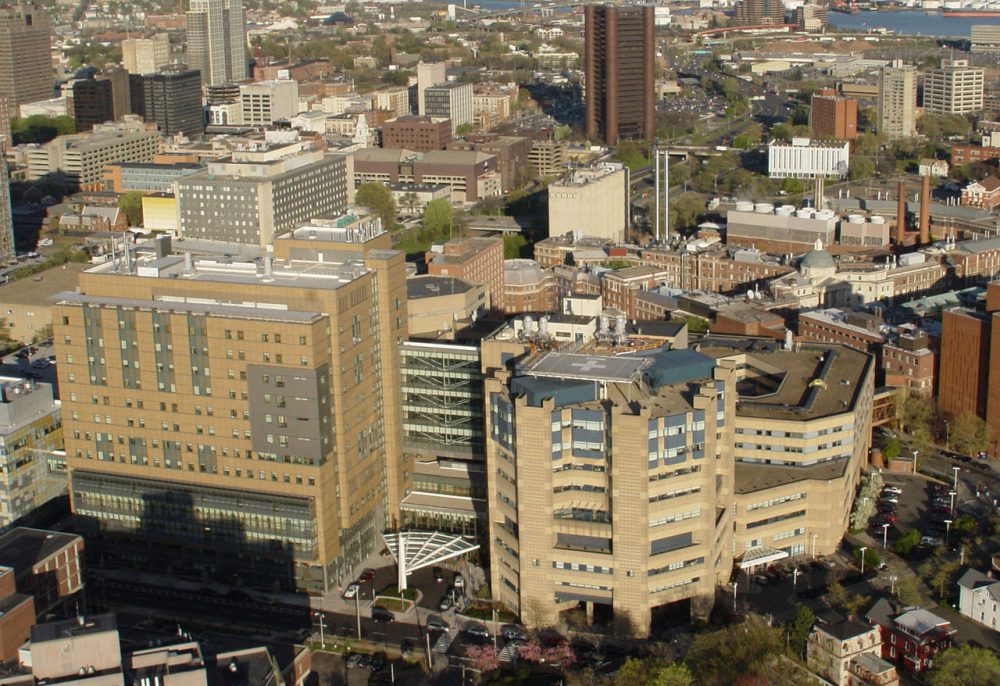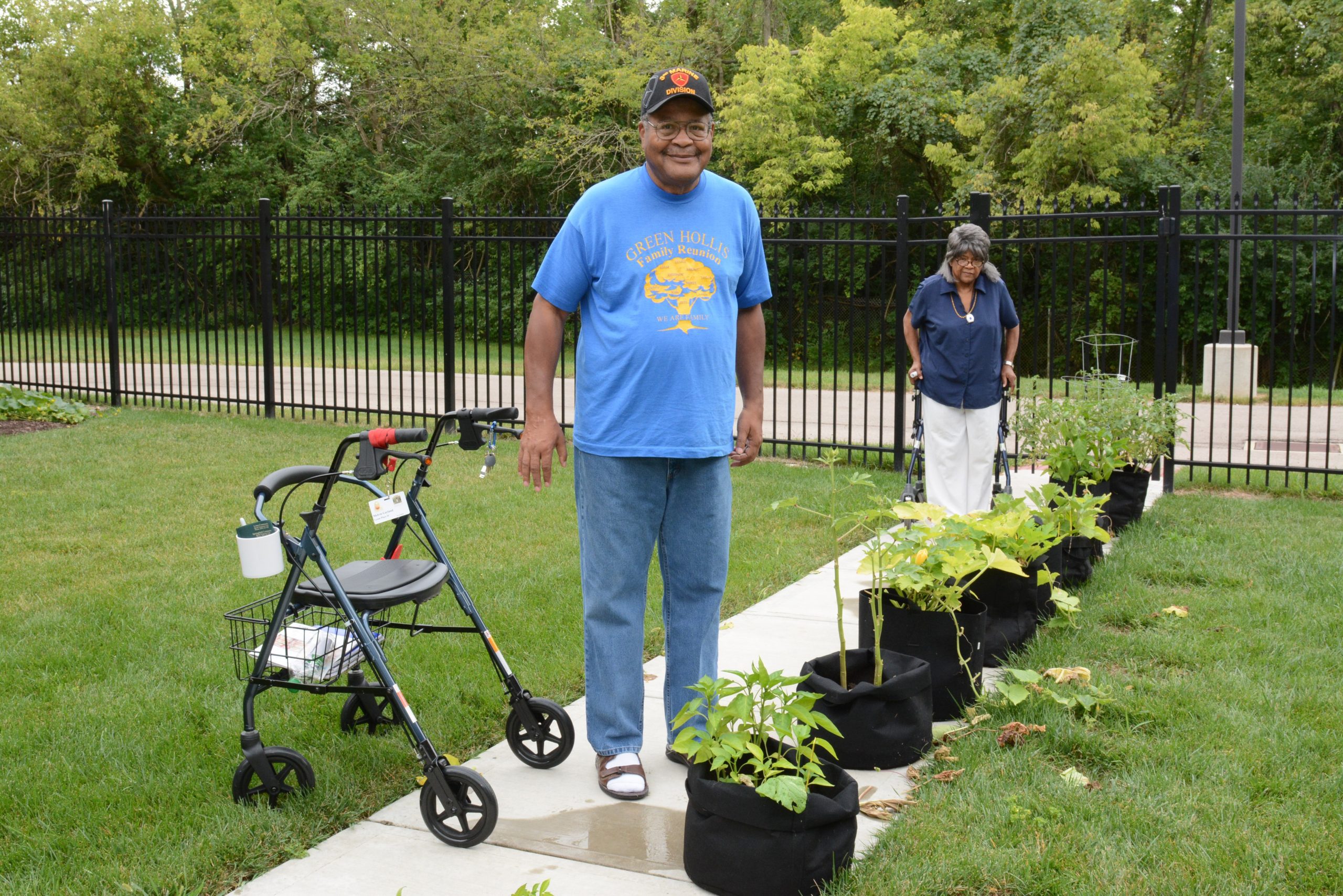
An aerial view of the campus of Yale-New Haven Hospital in Connecticut. In 2019, the hospital announced an $800 million plan to develop a new neuroscience center. Residents who live near that project raised concerns about displacement and the potential environmental effects of new development. Photo via Wikimedia Commons
Over the course of my medical training I have worked in cities that hold the dual distinctions of being both home to some of the largest medical institutions in the country as well as the sites of increasingly untenable affordable housing crises. I have seen countless patients bear the consequences of unsafe or unstable housing on their bodies and minds: the mold exacerbating their asthma, the medication missed because of stays in shelter leading to uncontrolled diabetes, the missed rent payments and threatening landlords leading to gnawing anxiety. These realities make clear that safe, affordable housing is a necessary foundation for good health, a fact that is now only further emphasized by the need for safe places to self-isolate during the COVID-19 pandemic.
However, as I pursued my training in Baltimore and New York City, it also became clear that medical institutions and health systems bore some responsibility in creating the pressures that drove displacement in the first place. Just as it was impossible to ignore the health impacts of poor housing, it was also increasingly difficult to ignore announcements of new multimillion dollar developments bearing the health systems’ names, the contrast between steel and glass research buildings and the rows of vacant houses just beyond their lawns. Participating in grassroots efforts to support fair development and sustainable affordable housing, led by groups such as the Baltimore Fair Development Roundtable and Northwest Bronx Community and Clergy Coalition, I heard stories from those living in the shadow of the hospital of rising rents and changing neighborhoods; I saw the looks of suspicion on community members’ faces when the hospital’s name arose in conversation.
Over the last few years there has been a growing commitment from health care institutions to the development of affordable housing. It’s a prospect that is both exciting and long overdue: the added financial and political weight of these anchor institutions as well as the opportunity for new collaborations between housing and health providers could improve access to both essential needs.
In moving forward with these initiatives, however, it is important that we consider the ways in which health care institutions already shape the communities in which they find themselves. The way that medical institutions actively engage in development, how their workforce shapes the characteristics of the neighborhoods around them, and how changing dynamics of health care service provision affect the vitality of neighborhoods must be reckoned with if health care systems decide to commit themselves to supporting true affordable housing.
While health care institutions may just now be entering the world of affordable housing, they are by no means new to community development. In 2001, Johns Hopkins Medical Institutions partnered with the city of Baltimore under then-mayor Martin O’Malley to form a $1.8 billion plan to redevelop the neighborhood surrounding the medical campus, known as the Middle East. Through the formation of East Baltimore Development Incorporated, the hospital and the city embarked on an 88-acre redevelopment plan on land that was then occupied by close to 800 households, home to those who lived in the shadow of the hospital.
The plans were met with vocal opposition from community members. As Maricela Gomez, organizer with Save Middle East Action Committee (SMEAC) wrote in this Shelterforce piece, SMEAC engaged in community surveying and door-knocking campaigns as well as direct actions to highlight the potentially disastrous impact this development would have on the primarily poor, Black communities surrounding the medical campus. Ultimately, however, the hospital and the city used eminent domain to push through their development plans. In return, compensatory payments were made to those who were forced to move, which organizers were successful in increasing from the original proposed amount of $22,500 to as much as $250,000.
As a medical student on the Johns Hopkins campus in the aftermath of this struggle, I saw new research buildings seemingly rise up overnight while down the street neighbors struggled to pay their ever-increasing rent. To the locals who know the hospital as much for its clinical care as for its exploitation of unwitting Black and Brown patients, the sight of an expanding campus seemed yet another chapter in the hospital’s long history of extracting resources from its surrounding neighborhoods.
This is by no means the only example of a hospital’s development plans drastically altering the neighborhood around it. In April 2019, Yale New Haven Hospital announced an $800 million plan to develop a new neuroscience center that would be completed by 2024. Residents who live near that project also raised similar concerns about displacement and the potential environmental effects of new development, according to the New Haven Register.
Health systems across the country engage in similar development projects, driven by the desire for ever newer clinical spaces and research facilities. Simultaneously embarking on new affordable housing projects does not negate these existing development efforts. Making a true commitment to addressing the housing crisis would mean not only dedicating resources to new housing, but also critically examining ongoing development practices to ensure that they are not further exacerbating displacement.
Even medical institutions that do not actively engage in neighborhood-altering development practices inevitably shape the composition of the communities around them. Each of the stages of my medical training necessitated my move into a new city, and the same holds true for many of the thousands of medical trainees who are matched to new institutions each year. What’s more, these stages of training are by their nature finite: once finished, some trainees may choose to stay, while others move either to pursue further training or job opportunities. What this process creates is a changing cohort of new, relatively high-earning individuals, often with little connection to the community in which they find themselves. It’s a situation ripe for the phenomena that we associate with gentrification: housing markets, retail markets, and businesses shape themselves to the wills and desires of this new group. The observation that large employers can drive shifts like this is not new. However, it is one that must be acknowledged as health institutions seek to engage in community development. Specifically, if those of us in health care are seeking to develop new ways to help our patients stay in their homes, part of that must also be finding ways to temper our own unintended impacts on the communities that we inhabit.
Losing Local Hospitals
The changing dynamics of health care service provision also pose a threat to the viability of changing communities. Across the country, the last few decades have seen the acquisition and subsequent closure of numerous local hospitals, many of which served as the main source of medical care for the primarily poor communities surrounding them. In New York City, closures of up to 18 hospitals have led to the loss of approximately 20,000 hospital beds, and further closures are still planned. These closures—done with the backing of state and local policymakers—follow a clear pattern of de-prioritization of low-income communities. What is also clear is that these decisions alter the landscape of medical resources available to those who remain in the surrounding neighborhoods. Many of these hospitals are being replaced by standalone urgent care centers, emergency departments, or ambulatory surgical centers that offer the promise of more advanced care, but at a more prohibitive cost. Furthermore, there is a question whether these private entities are bound by the same regulations that require Medicare-funded institutions to provide care to all patients regardless of ability to pay.
Ultimately these shifts in health care provision are altering the availability of medical services in neighborhoods across the country. In combination with increasing costs of living and ever-rising rents, this shift in services is part of a pattern that makes it increasingly difficult for poor people to stay in their homes. A real commitment from health care institutions to keeping people in their homes would mean reconsidering how health systems prioritize the medical services they provide in low-income neighborhoods, so that staying housed also means having ready access to necessary resources, including medical care.
The federal eviction moratorium will expire at the end of the month. At that point, hundreds of thousands of families will be at risk of losing their homes in the midst of a deadly pandemic. Now more than ever the health consequences of unstable housing are clear, and so it is both an exciting and necessary development to have health care institutions engaged in working toward new solutions for the creation of sustainable, long-term affordable housing. At the same time, health care institutions must be able to acknowledge and reckon with their own role in creating the housing crisis.
Above all, this means engaging with local community organizations in supporting their priorities. Many of these organizations have spent years exploring how development in their communities can proceed equitably and that expertise must be taken into account. Health care institutions should thus find ways to support community-based solutions for fair development, for example, making capital investments—either funding or hospital-owned land—in community land trusts and other mechanisms that prioritize community control and long-term affordable housing. Partnerships with local organizations can also guide how hospital affiliates can relocate responsibly, in ways that don’t harm neighborhoods. New hospital-driven development projects should also include explicit commitments to including truly affordable housing, with measures of affordability tailored to the realities of the local community. Finally, maintaining the viability of affordable housing also means ensuring the availability of necessary resources for the residents of that housing, including supporting, rather than closing, the local hospitals serving those communities.
Through profit-motivated development practices that have affected neighborhood composition, and dictating the medical services available to communities in need, health care institutions have long played a part in development and neighborhood change. A true commitment to stable affordable housing thus means not only a proactive engagement in developing new housing, but also revisiting ongoing practices to ensure that that housing and those neighborhoods remain viable and healthy.





This article is very timely. In San Francisco, the UCSF health care system is planning an enormous development project, completely out of scale with the surrounding neighborhood and violating prior agreements to limit expansion at this site. There is a hearing today at the SF Board of Supervisors Land Use Committee and at the full Board tomorrow, asking that the UC Board of Regents postpone a decision on this project until March, 2021. Letters to the BOS supporting this resolution would be much appreciated.
I read this article with great interest, especially because the observations and insight come from someone who works in the health care industry. Thank you for taking the time to write it.
Yes, this is well documented & told, but, it’s an old storyline. Civic success is still defined in urban planning terms — physical & growth development of professional & commercial real estate opportunities, aligned with the city’s or county’s adopted long-term “vision”. Community organizations have no influence in this arena — they’ve allowed “success” to remain defined in corporate terms, rather than in socioeconomic terms. Unless/until this practice is addressed, do not expect the tail to wag the dog.